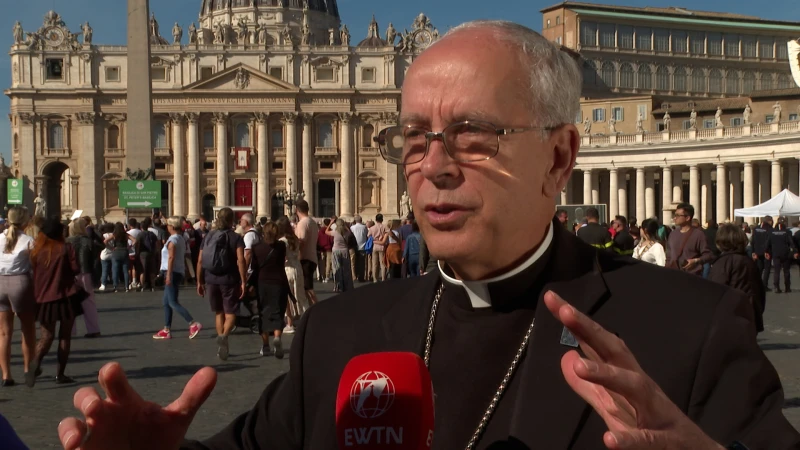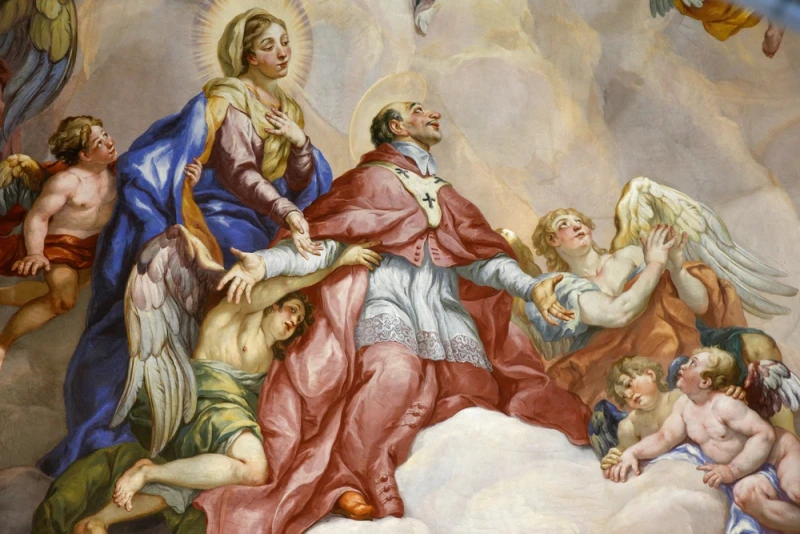![How pregnancy centers help women: Centers provide $450 million in value, report finds #Catholic
Jessica Williams and her 3-year-old daughter were helped by First Choice Pregnancy Services in Las Vegas. / Credit: Photo courtesy of Susan B. Anthony Pro-Life America
CNA Staff, Nov 17, 2025 / 16:11 pm (CNA).
When Jessica Williams became pregnant with another man’s child while she and her husband were separated, her husband pressured her to abort the child.As soon as she took the first abortion pill, mifepristone, she regretted it. “As a nurse, the reality of what I had done had hit me hard,” said Williams, who was nine weeks pregnant at the time. “Here I was working to save lives and about to take one of my own child’s lives.” But as a nurse, Williams knew that in spite of the pill cutting off the progesterone supply to her child, the baby might still be alive. She hadn’t yet taken the second pill, misoprostol, which would expel the child from her body. When she found a pregnancy center, First Choice Pregnancy Services in Las Vegas, staff immediately brought her in for an ultrasound.“They provided a free ultrasound, and that moment changed everything,” she said. Her baby was still alive.First Choice helped her through the abortion pill reversal process, a practice to reverse the effects of mifepristone soon after the woman takes the first abortion pill. Now, her daughter is a “healthy” and “thriving” 3-year-old, Williams said when she shared her story at a Nov. 17 online press conference.Williams is one of many women who have received help from pregnancy resource centers. Pregnancy centers across the U.S. “provided over $452 million in total medical care, support and education services, and material goods in 2024,” according to a Nov. 17 report by the Charlotte Lozier Institute. Pregnancy centers saw a total of 1 million new patients last year, “which is the equivalent of each center serving a new client every day in 2024,” Karen Czarnecki, the head of Charlotte Lozier Institute, said during the press conference. During the press conference, Marjorie Dannenfelser, head of Susan B. Anthony Pro-Life America, called pregnancy centers the “beating heart” of pro-life movement. Pregnancy centers, Dannenfelser said, “are going to the roots of the problem” by providing support for mothers across the board, whether they are struggling with addiction, domestic abuse, homelessness, completing school, or any other challenge. Report debunks false claims about pregnancy centers Dannenfelser noted there are some claims “often unchecked in the media” that call pregnancy centers “fake clinics” or say they “don’t have licensed medical staff.”“This is flat-out false,” Dannenfelser said. “Eight in 10 centers are providing free or low-cost medical services, staffed by over 10,000 medical professionals.” More than 80% of these centers provide ultrasound services, according to the report. Many of the centers also provide STD and STI testing and treatment, as well as abortion pill reversal, like in Williams’ experience. The report also found a 98% satisfaction rate among their clients — something Williams attested to.“They greeted me gently and were nonjudgmental,” Williams said of the staff and volunteers at the pregnancy clinic she went to. “They provided a safe, calm space for me, emotionally, spiritually.”“They gave me information and education without pushing me in any direction,” she continued. “They simply supported me in whatever path I chose.”More than three years later, Williams still keeps up with the women at the clinic.“I’m meeting with these ladies every month still,” Williams said. “They’re just a phone call, a text away, anything I need. I mean, we’re just almost becoming a family now.” Pregnancy centers also provide material, educational, and emotional support. For instance, 92% of centers offer material items to women in need. On average, each pregnancy center distributed six-packs of diapers and five baby outfits every day, according to the report. First Choice “provided diapers, material support, emotional and spiritual support groups, parenting resources, community connections, and just so much practical help in general,” Williams said. “It was a level of compassion that carried me through my entire pregnancy.” Offering material support is a growing effort in the pro-life movement. At pregnancy centers, material support has grown by more than 300% from 2019 to 2024.Many pregnancy centers also offer a variety of other resources, including childbirth classes, breastfeeding consultations, and outreach to victims of human trafficking. “Even right now, they’re doing a monthly get-together — we get to network with other mamas,” Williams said. “We’re [able] to access any resources.” The majority of pregnancy centers also help support women who are recovering from abortions.Williams said the women at the clinic “understood the pressure and fear” she was under to abort. Even after the reversal, her husband drove her to an abortion clinic when she was 16 weeks pregnant “to finish the job,” she said. “The clinic was on the same exact street [where] I saved my baby,” she said. “I couldn’t do it and demanded he take me home. I now know that the strategic location has also saved many other babies.” “They created a safe place for me to heal and feel supported,” she said of the clinic.](https://unitedyam.com/wp-content/uploads/2025/11/how-pregnancy-centers-help-women-centers-provide-450-million-in-value-report-finds-catholic-jessica-williams-and-her-3-year-old-daughter-were-helped-by-first-choice-pregnancy-services-in-las-v.webp)

Jessica Williams and her 3-year-old daughter were helped by First Choice Pregnancy Services in Las Vegas. / Credit: Photo courtesy of Susan B. Anthony Pro-Life America
CNA Staff, Nov 17, 2025 / 16:11 pm (CNA).
When Jessica Williams became pregnant with another man’s child while she and her husband were separated, her husband pressured her to abort the child.
As soon as she took the first abortion pill, mifepristone, she regretted it.
“As a nurse, the reality of what I had done had hit me hard,” said Williams, who was nine weeks pregnant at the time. “Here I was working to save lives and about to take one of my own child’s lives.”
But as a nurse, Williams knew that in spite of the pill cutting off the progesterone supply to her child, the baby might still be alive. She hadn’t yet taken the second pill, misoprostol, which would expel the child from her body.
When she found a pregnancy center, First Choice Pregnancy Services in Las Vegas, staff immediately brought her in for an ultrasound.
“They provided a free ultrasound, and that moment changed everything,” she said.
Her baby was still alive.
First Choice helped her through the abortion pill reversal process, a practice to reverse the effects of mifepristone soon after the woman takes the first abortion pill.
Now, her daughter is a “healthy” and “thriving” 3-year-old, Williams said when she shared her story at a Nov. 17 online press conference.
Williams is one of many women who have received help from pregnancy resource centers.
Pregnancy centers across the U.S. “provided over $452 million in total medical care, support and education services, and material goods in 2024,” according to a Nov. 17 report by the Charlotte Lozier Institute.
Pregnancy centers saw a total of 1 million new patients last year, “which is the equivalent of each center serving a new client every day in 2024,” Karen Czarnecki, the head of Charlotte Lozier Institute, said during the press conference.
During the press conference, Marjorie Dannenfelser, head of Susan B. Anthony Pro-Life America, called pregnancy centers the “beating heart” of pro-life movement.
Pregnancy centers, Dannenfelser said, “are going to the roots of the problem” by providing support for mothers across the board, whether they are struggling with addiction, domestic abuse, homelessness, completing school, or any other challenge.
Report debunks false claims about pregnancy centers
Dannenfelser noted there are some claims “often unchecked in the media” that call pregnancy centers “fake clinics” or say they “don’t have licensed medical staff.”
“This is flat-out false,” Dannenfelser said. “Eight in 10 centers are providing free or low-cost medical services, staffed by over 10,000 medical professionals.”
More than 80% of these centers provide ultrasound services, according to the report. Many of the centers also provide STD and STI testing and treatment, as well as abortion pill reversal, like in Williams’ experience.
The report also found a 98% satisfaction rate among their clients — something Williams attested to.
“They greeted me gently and were nonjudgmental,” Williams said of the staff and volunteers at the pregnancy clinic she went to. “They provided a safe, calm space for me, emotionally, spiritually.”
“They gave me information and education without pushing me in any direction,” she continued. “They simply supported me in whatever path I chose.”
More than three years later, Williams still keeps up with the women at the clinic.
“I’m meeting with these ladies every month still,” Williams said. “They’re just a phone call, a text away, anything I need. I mean, we’re just almost becoming a family now.”
Pregnancy centers also provide material, educational, and emotional support. For instance, 92% of centers offer material items to women in need. On average, each pregnancy center distributed six-packs of diapers and five baby outfits every day, according to the report.
First Choice “provided diapers, material support, emotional and spiritual support groups, parenting resources, community connections, and just so much practical help in general,” Williams said. “It was a level of compassion that carried me through my entire pregnancy.”
Offering material support is a growing effort in the pro-life movement. At pregnancy centers, material support has grown by more than 300% from 2019 to 2024.
Many pregnancy centers also offer a variety of other resources, including childbirth classes, breastfeeding consultations, and outreach to victims of human trafficking.
“Even right now, they’re doing a monthly get-together — we get to network with other mamas,” Williams said. “We’re [able] to access any resources.”
The majority of pregnancy centers also help support women who are recovering from abortions.
Williams said the women at the clinic “understood the pressure and fear” she was under to abort. Even after the reversal, her husband drove her to an abortion clinic when she was 16 weeks pregnant “to finish the job,” she said.
“The clinic was on the same exact street [where] I saved my baby,” she said. “I couldn’t do it and demanded he take me home. I now know that the strategic location has also saved many other babies.”
“They created a safe place for me to heal and feel supported,” she said of the clinic.
Read More


















![State-level religious freedom protections grow in recent years #Catholic
Thirty states have adopted some version of the Religious Freedom Restoration Act (RFRA) first signed into law by President Bill Clinton in 1993. / Credit: Leigh Prather/Shutterstock
Washington, D.C. Newsroom, Oct 21, 2025 / 17:56 pm (CNA).
Protections for religious freedom in the U.S. have grown in recent years with multiple states adopting laws to strengthen the constitutional right to freely exercise one’s religion.As of 2025, 30 states have adopted a version of the federal Religious Freedom Restoration Act (RFRA) or similar legislative protection for religious freedom. The most recent states to adopt those protections for state-level laws were Georgia and Wyoming in 2025 and Iowa, Utah, and Nebraska in 2024. West Virginia and North Dakota adopted them in 2023 and South Dakota and Montana did the same in 2021.RFRA was first adopted in 1993, when then-President Bill Clinton signed it into law to expand religious freedom protections. Under the law, the federal government cannot “substantially burden” the free exercise of religion unless there is a “compelling government interest” and it is carried out in the “least restrictive” means possible.Congress passed the law in response to the 1990 Supreme Court decision in Employment Division v. Smith, which asserted that the First Amendment was not violated as long as a law was “neutral and generally applicable.” The law was intended to provide a stronger safeguard for the free exercise of religion than what was provided by the highest court. Bipartisan consensus gone, but opposition weakeningWhen RFRA was adopted at the federal level in the 1990s, the protections had overwhelming bipartisan support. In the 2010s, that bipartisan consensus waned as most Democrats voiced opposition to the protections.Tim Schultz, the president of the 1st Amendment Partnership, told CNA that in 2013, two states adopted RFRA with nearly unanimous support from Republicans and about two-thirds support from Democrats. However, the law became more divisive after the 2014 Supreme Court ruling in favor of exempting Hobby Lobby from a mandate to provide abortifacient drugs based on RFRA.“That [bipartisan support] seems like a million years ago,” Schultz said. “Now I would say Republican support is about the same as it was then. Democratic support is under 5%.”Although Schultz did not express optimism that bipartisan support could return any time soon, he credited some cultural shifts for the strong success in Republican-leaning states over the past four years.From 2014 through 2020, he said business groups and LGBT groups “were working together very strongly … in opposition to religious freedom bills” because they saw them as threats to certain anti-discrimination laws related to workplace policies from religious employers.However, post-2020, he said, “the politics of RFRA are far more favorable,” and he noted there has been “far less opposition from business groups.”One reason for this change, according to Schultz, was the widely-published story of NCAA championship swimmer Lia Thomas, a biologically male swimmer who identified as a transgender woman and competed in women’s sports. This led polling to “change on every issue related to LGBT,” he noted.Another reason, he argued, was the response to transgender-related policies by Target and the Bud Light ads, which led to “consumer anger at both of them.” He noted the money lost by the corporations “made business groups say ‘we are not going to have the same posture.’”In spite of the partisanship that fuels the current debate, Schultz noted RFRA has been used to defend religious freedom on a wide range of issues, some of which have pleased conservatives and others that have pleased progressives.Although RFRA has been used to defend religious freedom on issues related to contraception, abortion, gender, and sexuality, it has also been used to defend religious organizations that provide services for migrants. “[RFRA is] not politically predictable,” Schultz said.](https://unitedyam.com/wp-content/uploads/2025/10/state-level-religious-freedom-protections-grow-in-recent-years-catholic-thirty-states-have-adopted-some-version-of-the-religious-freedom-restoration-act-rfra-first-signed-into-law-by-president.webp)



![Trump administration expands IVF and other fertility treatment coverage #Catholic
The Trump administration will expand access to in vitro fertilization drugs and procedures. / Credit: sejianni/Shutterstock
CNA Staff, Oct 16, 2025 / 18:53 pm (CNA).
President Donald Trump is expanding access to in vitro fertilization and other fertility treatments by partnering with pharmaceutical companies and expanding insurance options. According to a White House announcement on Oct. 16, the Trump administration is working with major pharmaceutical companies to bring IVF drugs to the U.S. at lower prices. The administration is also expanding insurance coverage for fertility care.The agreement with leading pharmaceutical group EMD Serono will make IVF drugs available “at very, very heavily reduced prices — prices that you won’t even believe,” Trump said on Thursday in a livestream from the Oval Office. According to the announcement, women who buy directly from TrumpRx.gov, a website that will launch in January 2026, will get a discount equivalent to 796% of the negotiated price for GONAL-F, a widely used fertility drug.The FDA will also be expediting its review of an IVF drug that is not yet available in the U.S., which Trump said “would directly compete against a much more expensive option that currently has a monopoly in the American market, and this will bring down costs very significantly.”In addition, the Trump administration will enable employers to offer separate plans for fertility issues, comparable to the standard life, dental, and vision plans typically available from employers.“This will make all fertility care, including IVF, far more affordable and accessible,” Trump said. “And by providing coverage at every step of the way, it will reduce the number of people who ultimately need to resort to IVF, because couples will be able to identify and address problems early.” “The result will be healthier pregnancies, healthier babies, and many more beautiful American children,” Trump continued. These fertility benefits will include both IVF and other fertility treatments “that address the root causes of infertility,” according to the Oct. 16 announcement. “There’s no deeper happiness and joy [than] raising children, and now millions of Americans struggling with infertility will have a new chance to share the greatest experience of them all,” Trump said. IVF is a fertility treatment opposed by the Catholic Church in which doctors fuse sperm and eggs in a laboratory to create human embryos and implant them in the mother’s womb. To maximize efficiency, doctors create excess human embryos and freeze them. Undesired embryos are routinely destroyed or used in scientific research.Lila Rose, a devout Catholic and founder of the pro-life group Live Action, condemned the administration’s action, noting that “IVF kills more babies than abortion.”“Millions of embryos are frozen, discarded, or destroyed,” Rose said in a post on X on Oct. 16.“Only 7% of embryos created survive to birth,” she said. IVF is “not a solution to fertility struggles.” In response to Trump’s announcement, the March for Life celebrated the White House’s focus on children and fertility, while cautioning the administration to protect human life at all its stages, even as embryos. “March for Life appreciates that President Trump has heard and is responding to so many Americans who dream of becoming parents,” the March for Life said in a statement shared with CNA. “The desire for parenthood is natural and good. Children are a blessing. Life is a gift. The White House’s announcement today is rooted in these core truths.” The March for Life noted that “every human life is precious — no matter the circumstances” and urged policymakers to protect human life. “We continue to encourage any federal government policymaking surrounding IVF to prioritize protecting human life in its earliest stages and to fully align with basic standards of medical ethics,” the statement read. The group also welcomed “the administration’s commitment to making groundbreaking advancements in restorative reproductive medicine more accessible and available to American women.” Catholic institutes such as the Saint Paul VI Institute have pioneered a form of restorative reproductive medicine called NaProTechnology. “Naprotech” aims to discover and address the root cause of fertility issues via treatment and surgery if necessary. Some conditions that can affect fertility include endometriosis — which affects nearly 1 in 10 women — and polycystic ovarian syndrome (PCOS), the leading cause of infertility.“RRM aims to resolve rather than ignore underlying medical issues, increasing health and wellness while also restoring fertility, and responding to the beautiful desire for children while avoiding any collateral loss of human life,” March for Life stated.](https://unitedyam.com/wp-content/uploads/2025/10/trump-administration-expands-ivf-and-other-fertility-treatment-coverage-catholic-the-trump-administration-will-expand-access-to-in-vitro-fertilization-drugs-and-procedures-credit-sejianni-shu.webp)

![Faith-based ministries discuss how to further pro-life mission #Catholic
Kat Talalas, Amy Ford, Christopher Bell, and Sister Maria Frassati, SV, speak at the Leading with Love Conference at The Catholic University of America in Washington, D.C., on Oct. 8, 2025. / Credit: Tessa Gervasini/CNA
Washington, D.C., Oct 9, 2025 / 12:55 pm (CNA).
Pro-life leaders from across the country gathered this week to discuss how faith-based ministries are helping to cultivate a society that promotes human dignity and how others can advance the cause.The Leading with Love Conference at The Catholic University of America (CUA) in Washington, D.C., was sponsored by the Human Life Foundation and the Center for Law and the Human Person at The Catholic University of America’s Columbus School of Law. It was aimed at “empowering Christians to cultivate a culture of life within their local communities.”Jennie Bradley Lichter, president of the March for Life Education and Defense Fund, spoke to attendees Oct. 8 about the power of faith-based ministries, including The Guadalupe Project. Lichter founded the initiative in 2022 to provide resources and encouragement to parents within the CUA community.To cultivate this encouragement, we must figure out how we can “create more of a revolution of love,” Lichter said. “Christ started this revolution of love, but it’s now up to each one of us in our particular time and place.”“Caring for unborn babies and their mothers is one of the most urgent challenges of our time, Lichter said. “Six out of 10 women who have chosen abortion would have preferred to choose life if they had the emotional and financial support they felt necessary.” The Guadalupe Project’s goal was to combat this by “[making] sure every woman on campus knows that resources exist and knows exactly how to find them,” Lichter said. “It’s meant to support all parents on campus, not just students, and not just mothers in unexpected or challenging circumstances.”“We wanted to foster a culture on campus where each life is celebrated, knowing that a positive, vibrant, and joyful culture of life is truly life-giving in so many ways,” Lichter said. The initiative “revamped all of the university’s pregnancy resource materials for students” and created “a poster campaign, including one designed specifically for the men’s dorms,” Lichter said.It also promoted the placement of stickers in every women’s restroom stall on campus with a QR code leading to these pregnancy materials. The campus started allotting more maternity and paternity leave, designating maternity parking spots on campus, providing free diapers and wipes at the campus food pantry, holding maternity clothing drives, and “affirming the goodness of family life and that new babies are a moment to celebrate,” Lichter said.The 2026 theme for the March for Life is “Life Is a Gift,” Lichter said. The initiative helps carry that out, because “life is something to be celebrated.” She added: “[Life] is not a burden for which someone needs support, or not solely that. It is really a cause for celebration.” Faith-based communities can use The Guadalupe Project as “prototype,” Lichter suggested. She shared that other universities have reached out to talk about the initiative as they were inspired to consider doing something similar.“We need to make sure that pregnant women never reach the point of despair that drives them into the arms of the abortion clinics,” Lichter said. “We need to meet that moment of loneliness, fear, or emptiness with encouragement and empowerment.”Hopes and suggestions for faith-based ministries Other leaders from prominent pro-life ministries discussed what gives them hope for the future of the pro-life movement, including Kat Talalas of Walking with Moms in Need, Amy Ford of Embrace Grace, Christopher Bell of Good Counsel Homes, and Sister Maria Frassati of the Sisters of Life.Talalas, who is the assistant director of pro-life communications for the U.S. Conference of Catholic Bishops, said Walking with Moms in Need started five years ago but has already reached countless communities. The parish-based initiative is “to the point where we don’t even know a lot of the time what new diocese or parish is starting a Walking with Moms in Need, what new lives are being saved, [and] what new women are being accompanied,” Talalas said. “It’s taken on a life of its own. That’s the work of the Holy Spirit — the Holy Spirit convicting hearts.”“God guides us, we have each other, and we’re not alone. Just as we tell [mothers] that they’re not alone, we’re not alone in this movement. So what’s giving me hope is seeing the Holy Spirit catch fire and individual people saying: ‘I want to start talking with moms in need,’ and women saying: ‘I can do this,’” Talalas said. Talalas said the work all begins with prayer. “It’s sitting in the presence of the love of God, letting him love you, and seeing how the Holy Spirit convicts you … It begins with that individual conviction. If we’re not following God’s law, it doesn’t matter what we’re doing.”Ford, who leads Embrace Grace, which provides mothers support through local churches, said she has “noticed there’s a lot of people that seem like they have more of an open heart about Christianity, about spirituality … especially with the younger generation.” She added: “I think that’s something we can all have hope about.”To get involved, Ford said people need to carry out “the good works that God’s called us to do.” She posed the question: “What strengths and gifts did God put inside each of you that you can do?” While Bell’s ministry, Good Counsel, provides services including housing for homeless mothers and children and post-abortion healing services, he said every person can help by simply praying. He specifically called on people to pray in front of an abortion center. “If you have done it, do it again. If you’ve never done it, just go ... You don’t have to say anything. You didn’t have to look up. You don’t have to open your eyes. But your presence will mean the world,” Bell said. “The babies who will die there that day will know that you loved them … That’s the most important thing to do.”Sister Maria Frassati shared that “we could really grow in having more faith in what [God] is doing.”“The truth is that God is actually really working in so many ways,” she said. “God is faithful, and that really gives me a lot of hope that nothing that you give is ever wasted. Even if you walk with a woman who’s not receptive, there’s really no gift that has been offered to him that he has not kept sacred and precious in his heart.”](https://unitedyam.com/wp-content/uploads/2025/10/faith-based-ministries-discuss-how-to-further-pro-life-mission-catholic-kat-talalas-amy-ford-christopher-bell-and-sister-maria-frassati-sv-speak-at-the-leading-with-love-conference-at-the-ca.webp)

![Native American group loses religious freedom appeal at Supreme Court #Catholic
On Oct. 6, 2025, the U.S. Supreme Court denied a rehearing of the case filed by Apache Stronghold, a coalition of Native Americans and their supporters, that would have prevented the sale of a Native American sacred site to a mining company. / Credit: Photo courtesy of Becket
CNA Staff, Oct 8, 2025 / 12:00 pm (CNA).
A Native American group working to stop the destruction of a centuries-old religious ritual site has lost a last-ditch appeal to the U.S. Supreme Court to halt the transfer and obliteration of the Arizona parcel.The Supreme Court in an unsigned order on Oct. 6 said Apache Stronghold’s petition for a rehearing had been denied. The court did not give a reason for the denial.Justice Neil Gorsuch would have granted the request, the order noted. Justice Samuel Alito, meanwhile, “took no part in the consideration or decision” of the order. The denial likely deals a death blow to the Apache group’s attempts to halt the destruction of Oak Flat, which has been viewed as a sacred site by Apaches and other Native American groups for hundreds of years and has been used extensively for religious rituals. The federal government is selling the land to the multinational Resolution Copper company, which plans to destroy the site as part of a copper mining operation. The coalition had brought the lawsuit to the Supreme Court earlier this year under the federal Religious Freedom Restoration Act, arguing that the sale of the site would violate the decades-old federal statute restricting the government’s ability to encroach on religious liberty. The high court in May refused to hear the case. Gorsuch dissented from that decision as well, arguing that the court “should at least have troubled itself to hear [the] case” before “allowing the government to destroy the Apaches’ sacred site.”Justice Clarence Thomas dissented from the May ruling as well, though he did not add his dissent to the Oct. 6 denial of the appeal. In a statement, Apache Stronghold said that while the decision was "deeply disappointing, the fight to protect Oak Flat is far from over." The group vowed to "continue pressing our cases in the lower courts.""Oak Flat deserves the same respect and protection this country has long given to other places of worship," the group said. The coalition has garnered support from major Catholic backers in its religious liberty bid. Last year the U.S. Conference of Catholic Bishops joined an amicus brief arguing that lower court decisions allowing the sale of Oak Flat represent “a grave misunderstanding” of religious freedom law. The Knights of Columbus similarly filed a brief in support of the Apaches, arguing that the decision to allow the property to be mined applies an “atextual constraint” to the federal religious freedom law with “no grounding in the statute itself.”Though Apache Stronghold appears to have exhausted its legal options, the U.S. Court of Appeals for the 9th Circuit said on Aug. 18 that the Oak Flat site would not be transferred to Resolution Copper amid emergency petitions from the San Carlos Apache Tribe as well as the Arizona Mining Reform Coalition. That dispute is still playing out at federal court.](https://unitedyam.com/wp-content/uploads/2025/10/native-american-group-loses-religious-freedom-appeal-at-supreme-court-catholic-on-oct-6-2025-the-u-s-supreme-court-denied-a-rehearing-of-the-case-filed-by-apache-stronghold-a-coalition-of-na.webp)


